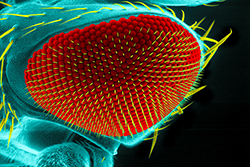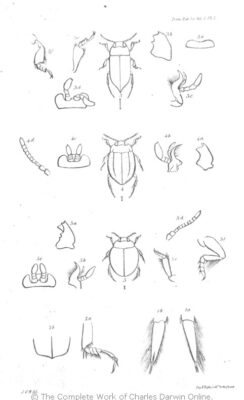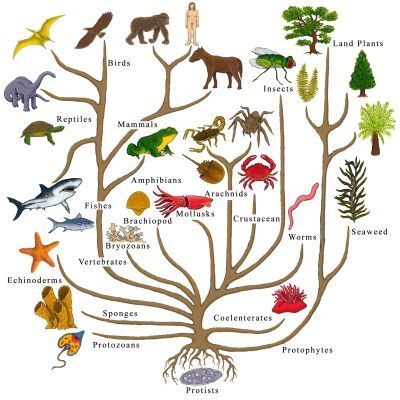
Charles Darwin‘s fascination with insects began early in life. While studying at Cambridge University, his interest continued with earnestness, as he sent James Francis Stephens, his professor of entomology (insects), specimens and descriptions of the critters.
At the time, discussing the evolution of insect genetics would have been as relevant as discussing moon landings. Just months before setting sail on the HMS Beagle in 1831, Stevens published his recognition of Darwin’s work on insects (pictured right) in his widely popular Illustrations of British Entomology.
Steven’s recognition fostered Darwin’s emerging credibility. In his Autobiography, Darwin noted –
“No pursuit at Cambridge [University] was followed with nearly so much eagerness or gave me so much pleasure as collecting beetles.”

During his 5-year voyage, Darwin’s “eagerness” for collecting insects continued. These were stored in crates and sent back to England for further study, along with myriad other specimens. While Darwin never recorded the number, naturalists, including Darwin, later illustrated many specimens and sometimes accompanied them with a description.
Despite more than a century of study, however, not a single insect tree of life has withstood the test of time. Finally, scientists now have the tools to study the evolution of insect genetics, revealing insights into their evolutionary secrets.
Scientific Consensus
The journal Science, earlier this month, published the most extensive insect genetics study ever undertaken. The study involved more than 100 scientists from 10 countries examining phylogenetics [phylo meaning family, race, tribe, or kind; genetics meaning “the genetic properties and phenomena of an organism] of 1,000 insect species – called the 1KITE project.
The project’s initial goal, launched in 2012, centered on tracing the “secrets of the evolutionary history of insects,” as detailed in the study “Phylogenomics resolves the timing and pattern of insect evolution.”
 The study was a logical necessity for the evolution industry. As lead author and professor Bernhard Misof of the Zoological Research Museum Alexander Koenig in Germany explains in an interview with Will Dunham writing for Rutgers, “two-thirds of all known animal species are insects,” yet their evolutionary relationships remain a mystery.
The study was a logical necessity for the evolution industry. As lead author and professor Bernhard Misof of the Zoological Research Museum Alexander Koenig in Germany explains in an interview with Will Dunham writing for Rutgers, “two-thirds of all known animal species are insects,” yet their evolutionary relationships remain a mystery.
The opening statement entitled “Toward an Insect evolution resolution” explains the logical necessity –
“Insects are the most diverse group of animals, with the largest number of species. However, many of the evolutionary relationships between insect species have been controversial and difficult to resolve.”
In the Abstract, the investigators explain their reason for performing the study –
“Insects are the most speciose group of animals, but the phylogenetic relationships of many major lineages remain unresolved.”
The emerging genomic revolution finally provided the technologies for investigators to validate molecular evolutionary relationships scientifically. Sponsored by the German government, the project’s stated purpose was to develop a scientific consensus on insect evolution. Specifically –
“Clarification of the phylogenetic tree and correct classification of the large insect groups are important prerequisites for being able to answer elementary questions related to evolutionary biology, ecology, and biodiversity research.”
The team planned to study “1478 single-copy nuclear genes obtained from genomes and transcriptomes representing [presumably] key taxa from all extant insect orders and other arthropods” – a daunting undertaking.
Daunting Numbers
In a study of this size, deciphering insect genetics proved to be a mind-blowing exercise. As Michael Wink (pictured right) of the University of Heidelberg explains –
“The sequences of 50 species can theoretically produce 2.8 x 10 [to the power of ] 74 phylogenetic trees, a number which is much more than the number of atoms found in the universe.”
To unravel insect genetics, supercomputers sorted and analyzed the genetic sequences. Unexpectedly, however, the findings were incompatible with initial expectations, even given the immense volume of data. As Kate Yandel, a science writer for The Scientist, noted –
“[Even using] an unprecedented quantity of genetic sequence information from insects… [uncovered] some unexpected conclusions.”
 “The scale of the project is amazing, not only in terms of the number of collaborators and the kind of scientists that were brought together, but also in the data. It was just enormous,” says Michelle Trautwein (pictured left), assistant curator and Schlinger Chair of Dipterology at the California Academy of Sciences in San Francisco, in an interview with PRI science writer Adam Wernick.
“The scale of the project is amazing, not only in terms of the number of collaborators and the kind of scientists that were brought together, but also in the data. It was just enormous,” says Michelle Trautwein (pictured left), assistant curator and Schlinger Chair of Dipterology at the California Academy of Sciences in San Francisco, in an interview with PRI science writer Adam Wernick.
Jakub Prokop, an entomologist at Charles University in Prague, Czech Republic, noted –
“The results of this work are immense and will be broadly adopted in general and systematic entomology books and textbooks.”
Study Findings
 However, rather than discovering evidence to support basic evolution assumptions, the study unexpectedly undermined the theory, as Misof explains why –
However, rather than discovering evidence to support basic evolution assumptions, the study unexpectedly undermined the theory, as Misof explains why –
“Sequence misalignment, and deviations from the underlying assumptions of applied evolutionary models.”
The research team addressed “these obstacles by removing confounding factors in our analysis” – i.e., eliminating outliers from the study. In the end, only 144 species were included in the study – not the original 1000 species, as planned. Amazingly, even by eliminating the outliers and reducing the number of species studied by nearly a factor of 10, they still failed to achieve the project’s initial goal.
The evidence points to stasis, not evolution. “If you had a time machine and you went back to the Jurassic, we entomologists would recognize all of the insects, and we could [classify] them into their proper order,” Karl Kjer (pictured left) of Rutgers University, one of the investigators, told Live Science.
“Many of them would look very similar to what we see today.”
Testing Predictions
“Scientists have been working to uncover the insect tree of life for a century,” Wernick opined in an interview with Trautwein. “The new study didn’t so much ‘provide shockingly new results’ — although that certainly is the case in some parts of the tree — but it did provide a huge, comprehensive amount of data.”
The testing proved each insect species to be genetically distinct and unique – contrary to initial speculations. No transitional links exist, as Darwin once predicted. This is why each species tested is illustrated at the top of each metaphorical phylogenetic tree branch (example pictured to the left); no insect qualified as a transitional link in Misof’s study.
Insect genetic evidence reinforces Darwin’s long-standing dilemma regarding the transitional link. In The Origin of Species, Darwin argued that the absence of –
“Numerous, successive, slight modifications [i.e., transitional links] are the most obvious and serious objection which can be argued against my theory.”
Insects have no known transitional links – materializing Darwin’s feared “serious objection” nightmare – scientifically.
 The absence of transitional links has long plagued the evolution industry. Legendary evolution advocate Stephen J. Gould (1977) of Harvard University identified this ubiquitous, long-standing, and persistent problem throughout the fossil record. In the article entitled “Evolution’s Erratic Pace” published in the journal Natural History, Gould notes –
The absence of transitional links has long plagued the evolution industry. Legendary evolution advocate Stephen J. Gould (1977) of Harvard University identified this ubiquitous, long-standing, and persistent problem throughout the fossil record. In the article entitled “Evolution’s Erratic Pace” published in the journal Natural History, Gould notes –
“The extreme rarity of transitional forms in the fossil record persists as the trade secret of paleontology. The evolutionary [phylogenetic] trees that adorn our textbooks have data only at the tips and nodes of their branches; the rest is inference, however reasonable, not the evidence of fossils.”
Darwin’s dilemma intensifies as the reach of science continues to expand. Evolutionary scientist Geir Hestmark of the University of Oslo comments in the journal Nature (2000) that remains relevant –
“Phylogenetic trees (example pictured left) are common in today’s scientific journals, but it is seldom realized how speculative they are because they look so real. This rhetorical power was significant in the popularization and triumph of evolutionary theory. Yet phylogenies are only sketches of historical hypotheses.”
Endangered Tree Metaphor
Misof’s insect genetics study further endangers Darwin’s once-famous tree metaphor – findings that align with evidence from the fossil record and molecular biology.
Eugene V Koonin (2011), of the Senior Investigator, National Center for Biotechnology Information (NCBI), National Library of Medicine (NLM), National, in his book entitled “The Logic of Chance,” concedes to the now unavoidable conclusion –
“The genomic revolution [has] effectively overturned the central metaphor of evolutionary biology, the Tree of Life.”
“The tree of life [concept] has come upon hard times,” laments evolution advocate John Archibald (2014) in his book entitled “One Plus One Equals One.” “The overall picture emerging is one of mosaicism” – not through Darwin’s theory of producing transitional links through the “slight, successive” changes of evolution.
Genesis
The genomic revolution continues to undermine long-held evolution speculations. However, the scientific evidence is compatible with the Genesis account written by Moses. Each species remains distinct and unique – as Mosfi’s insect genetics study demonstrates.
Evidence from molecular biology to validate the theory of evolution scientifically remains speculative.
Evolution of Insect Genetics is a Molecular Biology article.
Darwin Then and Now is an educational resource on the intersection of evolution and science, highlighting the ongoing challenges to the theory of evolution.
Move On
Explore how to understand twenty-first-century concepts of evolution further using the following links –
-
- The Understanding Evolution category showcases how varying historical study approaches to evolution have led to varying conclusions. Subcategories include –
- Studying Evolution explains how key evolution terms and concepts have changed since the 1958 publication of The Origin of Species.
- What is Science explains Charles Darwin’s approach to science and how modern science approaches can be applied for different investigative purposes.
- Evolution and Science feature study articles on how scientific evidence influences the current understanding of evolution.
- Theory and Consensus feature articles on the historical timelines of the theory and Natural Selection.
- The Biography of Charles Darwin category showcases relevant aspects of his life.
- The Glossary defines terms used in studying the theory of biological evolution.
- The Understanding Evolution category showcases how varying historical study approaches to evolution have led to varying conclusions. Subcategories include –
Evolution of Insect Genetics – 2021 Update
A phylogenetic tree for insects exists philosophically, not scientifically, as tacitly expressed by Wikipedia, the Smithsonian Institution, and the University of California’s Evolution 101.
WIKIPEDIA
-
- Insect page references Misof’s paper only once, stating –
“Insects form a single clade, closely related to crustaceans and myriapods.”
WIKIPEDIA does not include a phylogenetic tree for insects. Interestingly, while the term “evolution” appears 17 times in the text, the term never appears in the same sentence with the terms “genetic,” “genetics,” or “genome.”
-
- Insect Evolution page, one mention of Misof’s study appears –
“A report in November 2014 unambiguously places the insects in one clade, with the remipedes as the nearest sister clade. This study resolved insect phylogeny of all extant insect orders, and provides ‘a robust phylogenetic backbone tree and reliable time estimates of insect evolution.'”
-
- Evolution page, insects are only mentioned four times in the text; however, there is no mention or illustration of a phylogenetic tree for insects.
Smithsonian Institute
The Smithsonian insect collection is one of the largest entomological collections in the world, with over 35 million specimens. However, the institute website makes no mention or illustration of a phylogenetic tree for insects.
Searching the Institute’s website for “insect phylogenetic tree” and/or “insect genetics” failed to identify any relevant information.
Evolution 101
Evolution 101 website is a publication of the University of California, Berkeley.
While “insects” and “beetles” are widely referred to on many different pages as theoretical examples to illustrate possible mechanisms of evolution, the website does not address the phylogenetics of insects.
2021 Summary
A scientific consensus on the development of an insect phylogenetic tree remains unresolved within the evolution industry.
Scientific evidence from insect genetics justifies evolution skepticism.





